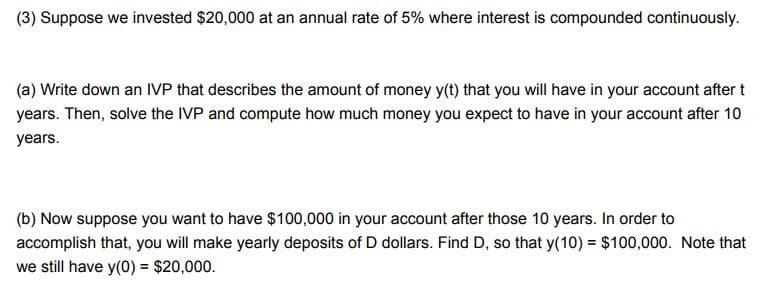(3) Suppose we invested $20,000 at an annual rate of 5% where interest is compounded continuously. (a) Write down an IVP that describes the amount of money y(t) that you will have in your account after t years. Then, solve the IVP and compute how much money you expect to have in your account after 10 years. (b) Now suppose you want to have $100,000 in your account after those 10 years. In order to accomplish that, you will make yearly deposits of D dollars. Find D, so that y(10) = $100,000. Note that we still have y(0) = $20,000. %3!
(3) Suppose we invested $20,000 at an annual rate of 5% where interest is compounded continuously. (a) Write down an IVP that describes the amount of money y(t) that you will have in your account after t years. Then, solve the IVP and compute how much money you expect to have in your account after 10 years. (b) Now suppose you want to have $100,000 in your account after those 10 years. In order to accomplish that, you will make yearly deposits of D dollars. Find D, so that y(10) = $100,000. Note that we still have y(0) = $20,000. %3!
Chapter6: Exponential And Logarithmic Functions
Section: Chapter Questions
Problem 8RE: Suppose an investment account is opened with aninitial deposit of 10,500 earning 6.25...
Related questions
Question
urgenttt........

Transcribed Image Text:(3) Suppose we invested $20,000 at an annual rate of 5% where interest is compounded continuously.
(a) Write down an IVP that describes the amount of money y(t) that you will have in your account after t
years. Then, solve the IVP and compute how much money you expect to have in your account after 10
years.
(b) Now suppose you want to have $100,000 in your account after those 10 years. In order to
accomplish that, you will make yearly deposits of D dollars. Find D, so that y(10) = $100,000. Note that
we still have y(0) = $20,000.
Expert Solution
This question has been solved!
Explore an expertly crafted, step-by-step solution for a thorough understanding of key concepts.
Step by step
Solved in 4 steps with 3 images

Recommended textbooks for you


Algebra & Trigonometry with Analytic Geometry
Algebra
ISBN:
9781133382119
Author:
Swokowski
Publisher:
Cengage


Algebra & Trigonometry with Analytic Geometry
Algebra
ISBN:
9781133382119
Author:
Swokowski
Publisher:
Cengage